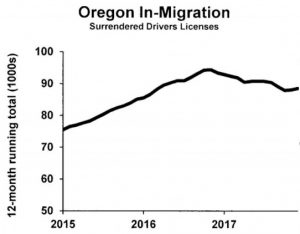
By Taxpayer Foundation of Oregon
The most recent population estimates from the Census Bureau show that Portland’s population growth has slowed to the lowest level in years.
The Portland metropolitan area—which includes Multnomah, Washington, and Clackamas counties, as well as Clark county in Washington—grew by a little more than 30,000 in 2017. That amounts to an increase of 1.2 percent. In contrast, the metro area added about 40,000 people a year in 2015 and 2016.
Economist Bill Conerly notes in his newsletter that migration to Oregon has also slowed. As shown in the figure above, the number of people from out-of-state who have surrendered their driver’s licenses has seen a similar slowdown. The number of surrendered licenses has dropped by more than five percent since 2016. Conerly blames Oregon’s high cost of living.
The reasons for slow down vary. One likely factor is the aging of the Millennial generation. As members of this mini Baby Boom enter their thirties and look to buy houses and raise families, they seek out suburbs and more affordable metropolitan areas. Research find that many of the metros with the fastest growth are those where buying a home remains feasible for middle income families. With rising interest rates and median home price of $390,000 (up 11.4 percent from a year earlier), Portland is no longer affordable for middle income families. Underperforming schools, rising property taxes and the perennial threat of new sales taxes, soda taxes, carbon taxes, and business taxes inject uncertainty that is surely a turnoff to potential residents.
According to the Oregon Department of Transportation, since 2013, morning travel times have increased by almost four percent and afternoon travel times have increased by nearly eight percent. This added time stuck commuting to and from work imposes a real cost on workers and families, diminishing the attractiveness of dense urban areas like Portland.
Other factors, such as increased burglaries in Portland’s residential neighborhoods, have reduced the attractiveness of Portland to potential new residents. In addition to the city’s growing homeless population, city policies have pushed homeless residents out of the urban core and into the outlying residential areas to the point that just about every Portland neighborhood has at least one homeless camp.
Portland’s slowdown in population growth is certainly due in part to broader demographic changes. Nevertheless, it is clear that public policy decisions have made the region less attractive to newcomers.
Disclaimer: Articles featured on Oregon Report are the creation, responsibility and opinion of the authoring individual or organization which is featured at the top of every article.


